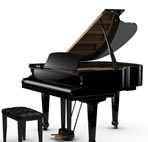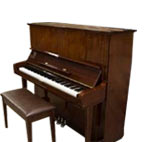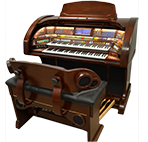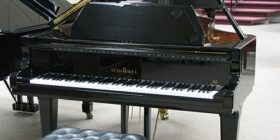IT MEASURES 7 FEET long and 5 feet wide, weighs 1,182 pounds (roughly the same as a 6-month-old baby elephant) and eats up valuable space in my living room. I use it, if I’m being honest, three or so hours a week. Practically speaking, I’d probably get more mileage out of a Ping-Pong or pool table.
Guilty pleasures come in all forms. Mine is a concert grand piano. There is no real reason why I should own one. I’m not a pianist, not really. I can play the melody with chords. Not unlike my singing in the shower, my piano performances are best done alone and out of anyone else’s earshot. That said, I find playing both calming and centering. Considering what a hand-crafted concert grand will cost you—upwards of $50,000 for a new one—therapy would be a whole lot cheaper, but that would cause pain, not pleasure, and pleasure is what a piano is for.
When I was growing up in suburban New Jersey, we had a spinet that nobody knew how to play. My father bought it for my mother as an 11th-hour Christmas gift. In 1990, when my parents moved to Florida, they passed the piano on to me, which gave me a reason in my antsy late 40s to take lessons (it was that or learn French).
Through a friend, I found a wonderful teacher, Bob Printz, who was willing to make the trip in from Rockland County to my Manhattan apartment and sit by my side for two hours every week. My job was to tap out the melody, which I did tentatively and by ear. Bob’s was to play the bottom part—i.e., the bass clef—which is much more difficult. We saw each other regularly, then sporadically (I became too busy at work) and now not at all. My loss.
Politically, Bob and I are miles apart: He’d walk into the apartment wearing his radio headphones tuned into a talk show whose views were the opposite of mine. But once he removed them and sat on the piano bench, he would play like Oscar Peterson or Bill Evans. I was enthralled. Bob and I had almost identical musical tastes, which include a love for Johnny Mercer and Hoagy Carmichael, Cole Porter, Rodgers and Hart and Hammerstein, Harold Arlen, Gershwin, Sondheim and the two Dukes (Vernon and Ellington).
The spinet was not up to Bob’s high standards, conservatory graduate that he was, although he never said so. After a year or so of lessons, I got it into my head to buy a bigger, better piano—maybe a used baby grand. The hunt began, with Bob as my guide.
I was determined not to spend more than $5,000 or $6,000. But as we went from store to store, one thing led to another and we found ourselves in Steinway Hall on West 57th Street, which was like walking into a Rolls-Royce showroom. The Steinway’s sound is rich and resonant but the cost prohibitive. I knew I had no place being there. So we made our way to a little spot on West 58th Street that specialized in more affordable makes including the highly regarded Baldwin.
The company was founded in 1862 in Cincinnati by one Dwight Hamilton Baldwin, who introduced its first grand piano in 1895. Famous Baldwinites include Igor Stravinsky, Aaron Copland, Leonard Bernstein, Marian McPartland, Liberace and Dave Brubeck. I’d be in good company. Now owned by Gibson (as in guitars) and based in Nashville, the pianos are currently made—no surprise here—in China.
Bob tested out several models. He checked for brightness, tone, action, pedal ease and other signs that were beyond me. He also looked under the lid of each piano, as one might inspect under the hood of a car (just to be sure there really was an engine there). As he finished playing a tune on what is called an SF10, he looked up and nodded in teacherly approval. To his ear, the Baldwin sounded more robust than the Steinway.
Next thing I knew, I plunked down $14,000 and change for a brand new grand piano in black satin “ebonized” wood (the year was 1991; in 2008, the same model listed for $76,500). It was delivered a day or two before Christmas by a team of men who rolled it—legless—into the apartment, then assembled it. “Huge” doesn’t begin to describe its presence. The living room, which had always looked a little lonely, now had a new omnivorous occupant.
I remember that first night. I was all alone (my husband had long gone to bed) wearing a bathrobe and slippers. I turned on the Christmas tree lights and the piano lamp and eked out a pathetic version of “Christmas Time is Here” from the soundtrack to “A Charlie Brown Christmas.” The sound—the Baldwin’s, not mine—was magnificent.
Soon, the piano began to feel like family. Others who played better than I would come by to spend time with it. I was as happy listening to them as playing to myself—happier, in fact. And I simply loved looking at it.
One frequent visitor, Mike Cannon, had his particular way with the Baldwin. I knew Mike from the magazine where we both worked, but years before, when he first came to Manhattan from Nashville, he set out to become the “white Bobby Short.” Alas, he never did. Mike looked a little like Fred Astaire and had a similar bearing. He wasn’t conventionally handsome but when he began to play the piano he turned into an angel.
Mike and I began to do informal little cabaret acts at home for family and friends at Thanksgiving and on other occasions. Once I hosted a fundraising event for the New York Public Library during which a group of total strangers watched Mike and me perform a 20-minute medley. Pretty nervy for a couple of amateurs, but it was great fun.
Another time, a real cabaret singer—the incomparable Barbara Cook—came by. Roger Sherman, a friend of mine, was doing a documentary on Richard Rodgers and asked if he could use the apartment for an interview with the diva. I left the keys for Roger, who placed Barbara on a high chair in front of the piano. Behind her sat Wally Harper, her longtime accompanist.
Later that day, I received a panicked called from Roger: “Pamela, a horrible thing happened. Barbara fell into the side of the piano and left a deep gash in it!” Barbara is not a small woman. Roger was mortified. I, on the other hand, considered it the Baldwin’s badge of honor. I eventually had it repaired, reluctantly.
I’m not the only member of my household who’s grown attached to the piano. When my husband and I were about to go away for a long weekend, we looked everywhere for Bunny, our precious cat. She wasn’t in any of her usual hiding places. I thought, I’ll bet she made a leap and is on top of the armoire. I got on the piano bench and surveyed the room. No Bunny. As I was about to come down, I noticed two yellow eyes glaring at me from deep inside the piano. It took some effort to extract the obstinate Bunny, but instead of getting mad all I could say was, “Clever girl!”
In 2007, Mike Cannon died of a degenerative disease that had left him unable to play the piano or speak, much less sing. Not long after, Bob Printz slipped on ice, ironically on his way to meet me for a lesson. The cause—vertigo—made him decide not to come to town any more. I abandoned the Baldwin for a while; just couldn’t go near it.
Then one day Boris, my trusty Russian tuner, called and asked if the Baldwin needed his services. That was about six months ago. I’ve been spending time with it ever since, usually around 7 p.m., accompanied by a glass of wine and some favorite easy-to-follow sheet music from what are called “fake books.” I must be improving, because I no longer hear my husband calling out from the next room that I’m “chasing the melody.” Moreover, the sound that comes from my beautiful baby elephant is not its usual trumpet but a jubilant and joyful noise that only a truly grand piano can make.
—Ms. Fiori is the former editor of Town & Country and Travel & Leisure magazines, and the author of five books, including “In the Spirit of Palm Beach.”










